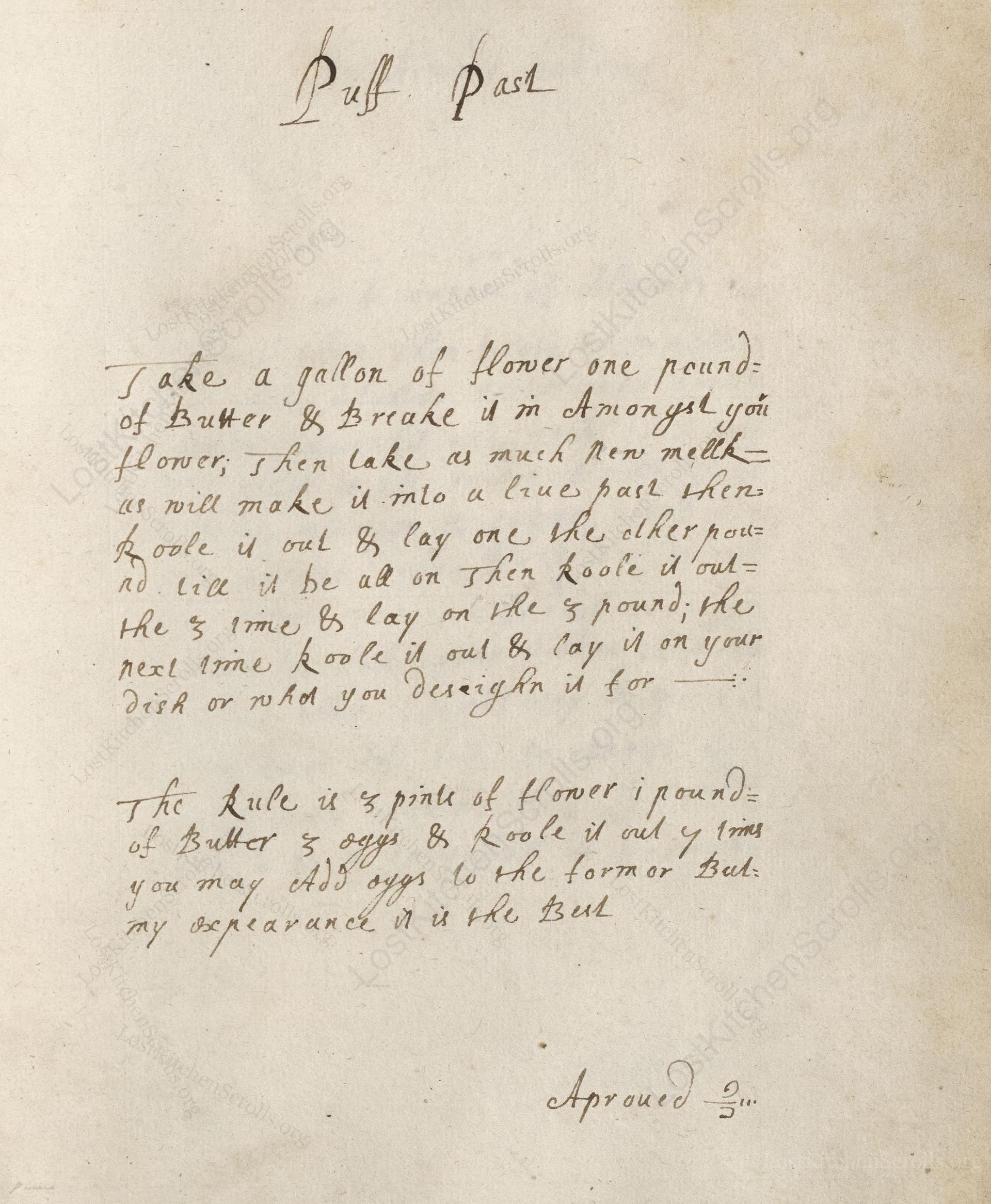Puff Past
From the treasured pages of Cookbook of Susanna Packe
Written by Susanna Packe

Puff Past
"Take a gallon of flower one pound= of Butter & Breake it in amongst you flower. Then take as much new melk= as will make it into a liue past then= Roole it out & lay one the other pou= nd till it be all on Then Roole it out= the 3 time & lay on the 3 pound. the next time Roole it out & lay it on your dish or what you deseighn it for -- The Rule is 3 pinte of flower 1 pound= of Butter 3 eggs & Roole it out 4 tims you may add eggs to the former But my appearance it is the Best Aproued Sr."
Note on the Original Text
This recipe is written using loose, practical instructions, typical of manuscript cookery from the period. Spellings reflect the orthographic instability of 17th-century English, e.g., 'past' for 'paste' (pastry), 'flower' for 'flour,' and 'liue' likely for 'live' (meaning moist, fresh). Measurements were approximate, with the expectation that the cook would judge consistency by eye and hand. Recommendations, such as adding eggs for richer dough, reveal a flexible approach to recipe writing—cooks were encouraged to use personal experience ("my appearance it is the Best") to guide them.

Title
Cookbook of Susanna Packe (1674)
You can also click the book image above to peruse the original tome
Writer
Susanna Packe
Era
1674
Publisher
Unknown
Background
A delightful culinary treasure from the 17th century, this book offers a charming glimpse into the flavors and techniques that graced English kitchens in Susanna Packe's time, promising a feast of history and taste for any food enthusiast.
Kindly made available by
Folger Shakespeare Library
This recipe originates from 'Packe, Susanna, fl. 1674,' manuscript V.a.215, dating to 1674. In Restoration England, cookery manuscripts were mainly kept by households to record and share culinary knowledge. Puff pastry, or 'Puff Past,' was a luxury item, prepared by those with the means and leisure, and such recipes show the evolution of lamination techniques long before modern pastry chefs codified them. The recipe displays both the creativity and improvisational nature of 17th-century cookery, relying on the cook’s familiarity with dough handling and their capacity to translate ratio-based guidelines into consistent results. Butter was a prized ingredient, used lavishly in this celebratory pastry.

Seventeenth-century cooks would have used a large wooden bowl or trough for mixing the dough, a rolling pin (often just a carved wooden cylinder), and a wide, flat board or table for rolling. Knives were used to cut and manage the butter, and the finished pastry would be placed in ceramic or metal pie dishes, or directly on a baking stone or in the hearth oven. No refrigeration: dough would be kept cool as best as possible by working quickly.
Prep Time
40 mins
Cook Time
0 mins
Servings
16
We've done our best to adapt this historical recipe for modern kitchens, but some details may still need refinement. We warmly welcome feedback from fellow cooks and culinary historians — your insights support the entire community!
Ingredients
- 2 lb 14 oz all-purpose/plain flour
- 1 lb unsalted butter, cold
- 1 3/4 to 2 cups whole milk (or enough to form dough)
- 3 large eggs (optional, for richer dough)
- Pinch of salt
Instructions
- Begin by weighing out 2 lb 14 oz of plain flour and 1 lb of chilled unsalted butter.
- Rub or cut half the butter into the flour.
- Gradually add whole milk, a bit at a time, until a soft but not sticky dough forms—this will likely be about 1 3/4 to 2 cups.
- Roll out the dough into a rectangle, dot or layer a third of the remaining butter over two-thirds of the dough, then fold like a leter.
- Repeat rolling out and buttering for a total of four turns, using all the butter in thirds at each stage.
- If desried, beat in 3 eggs with the milk to enrich the dough.
- After the fourth roll and fold, the pastry can be used to line a dish and is ready to bake according to your chosen filling or dish.
- Let the dough rest in the fridge between turns for best results.
- This puff pastry builds layers by folding and incorporating butter multiple times, a technique seen in traditional and modern puff pastry recipes.
Estimated Calories
450 per serving
Cooking Estimates
It takes about 40 minutes to prepare the ingredients and make the pastry dough, plus time to chill between folds. Baking time depends on the recipe you use the pastry for. Each serving has an estimated 450 calories, and this recipe makes 16 servings.
As noted above, we have made our best effort to translate and adapt this historical recipe for modern kitchens, taking into account ingredients nowadays, cooking techniques, measurements, and so on. However, historical recipes often contain assumptions that require interpretation.
We'd love for anyone to help improve these adaptations. Community contributions are highly welcome. If you have suggestions, corrections, or cooking tips based on your experience with this recipe, please share them below.
Join the Discussion
Rate This Recipe

Den Bockfisch In Einer Fleisch Suppen Zu Kochen
This recipe hails from a German manuscript cookbook compiled in 1696, a time whe...

Die Grieß Nudlen Zumachen
This recipe comes from a rather mysterious manuscript cookbook, penned anonymous...

Ein Boudain
This recipe comes from an anonymous German-language manuscript cookbook from 169...

Ein Gesaltzen Citroni
This recipe, dating from 1696, comes from an extensive anonymous German cookbook...
Browse our complete collection of time-honored recipes



